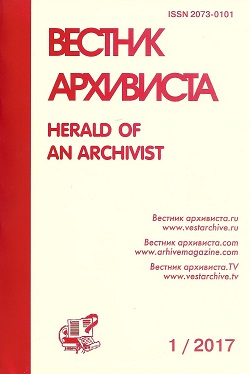Social Composition of Sacred Lands Tenants in Attica of the Second Half of the 4th Century B.C. according to Epigraphika



Scientific article
УДК 930.2+930.27+930.272+904+903.01+903.07+725.94+334.7+346.5+63-057.2
doi 10.28995/2073-0101-2023-2-331-341
Bulycheva, Elena V.
Russian State University for the Humanities, Moscow, Russian Federation
Social Composition of Sacred Lands Tenants in Attica of the Second Half of the 4th Century B.C. according to Epigraphika
Abstract
The article assesses social composition of holy lands tenants in Attica of the 4th century B. C. Epigraphic material is an important source for the study of various spheres of society in the Athenian polis. There remain inscriptions on stone steles containing data on leasing of sacred lands (temenos) in Attica, dating back to the second half of the 4th century B. C. Using their data, the researcher can consider a number of issues related to the history of agrarian relations in ancient Athens. However, this material has not been used by scholars for studying history of land relations in the Athenian polis. Thus, the article is to analyze social composition of temenos tenants in Attica in the second half of the 4th century B. C. on the basis of epigraphic material at our disposal, to present their motives for the transaction. The article uses as its main source texts of agreements on lease of sacred lands in Attica, published in collections of epigraphic material by I. Kirhner and H. Pleket and cited in the scientific journal Hesperia. These inscriptions detail terms of lease of land plots dedicated to gods and heroes, name tenants, and (in some cases) indicate their rights and obligations. Based on the analysis of tests of sacred lands lease agreements, the author comes to the conclusion that tenants of sacred lands in Attica in the second half of the 4th century B. C. were citizens of the polis. Their comparative analysis with inscriptions concerning private land leasing in the same period suggests that in the sphere of private land ownership there were cases when tenants were meteks, who did not have civil status. Prosopographic analysis of the temenos tenants’ names allows the author to assume that many had noble origins and were very famous people in the polis. The author also underscores the fact that, in some cases, social composition of sacred lands tenants depended on location of the land plot. In the central areas, lands of the largest sanctuaries were dominated by tenants with a high social status. Temenos on the periphery or coastal lands were mostly leased to commoners. The article also attempts to identify motives of citizens with a high social status for participating in the lease. Apparently, this was, primarily, fulfillment of a kind of liturgy before the polis, which consisted in obligation to maintain sacred land ownership, which had a special meaning. In general, it is concluded that the majority of tenants of sacred lands in Attica in the second half of the 4th century B. C. were citizens, in some cases, of high social status, which indicates a special attitude to sacred land ownership in the Athenian polis, a desire to preserve and develop this land fund in the best traditions of the civil collective.
Keywords
Historical sources, contract, conditions, Ancient Greece, land, land relations, citizen, policy.
Download the article: bulycheva_doi
References
BUZESKUL, V. P. Afinskaya demokratiya [Athenian Democracy. In Russ.]. Moscow, Veche publ., 2019, 480 p.
GUSHIN, V. R. Afiny na puti k demokratii VIII – V veka do n. e. [Athens on the road to democracy of the 8th–5th centuries B. C. In Russ.]. Moscow, Izdatel,skii dom Vysshei shkoly ekonomiki publ., 2021, 456 p.
WORTHINGTON, I. Athens after Empire. A History from Alexander the Great to the Emperor Hadrian.Oxford, Oxford University Press, 2020, 424 p.
About the authors
Bulycheva Elena Vladimirovna, PhD in Historym associate professor. Russian State University for the Humanities, department of world history, assistant professor, Moscow, Russian Federation,+7-963-765-52-05. This e-mail address is being protected from spambots. You need JavaScript enabled to view it
Submitted 11.10.2022, published (for citation):
BULYCHEVA, E. V. Sotsial'nyi sostav arendatorov svyashchennykh zemel' v Attike vtoroi poloviny IV v. do n. eh. po dannym ehpigrafiki [Social Composition of Sacred Lands Tenants in Attica of the Second Half of the 4th Century B.C. according to Epigraphika. In Russ.]. IN: Vestnik arhivista / Herald of an Archivist, 2023, no. 2, pp. 331-341. doi 10.28995/2073-0101-2023-2-331-341











